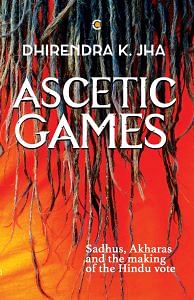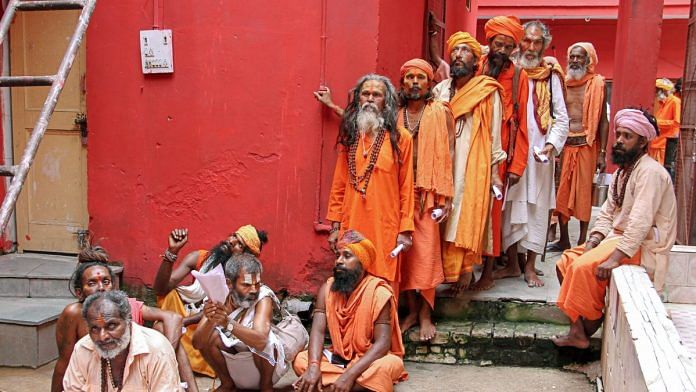Hinduism does not have a central authority or an overarching church-like organisation. Monastic orders that belong to a great number of sampradayas, or traditions, are at the core of this religion. The sadhus in these sampradayas, most often celibate monks, act as spiritual leaders for the lay followers. They are expected to offer religious discourses and promote practices that defend the centrality of the guru-bhakti tradition. Devotees believe that adhering to their teachings bring peace, prosperity and meaning in life and, eventually, salvation. Monastic orders of the Vaishnava or Shaiva traditions — Vishnu or his incarnates, like Ram or Krishna, are the principal deity of the former, and Shiva of the latter — control most of the ascetic space of Hinduism. Their strength is showcased in the largest Hindu religious gathering, the Kumbh Mela, held every twelve years in each of the four cities — Allahabad, Haridwar, Nasik and Ujjain—which commands worldwide media attention, particularly the bathing procession of naked Shaiva sadhus.
The two monastic orders have their own sets of mutts and ashrams, some of which have ambiguous institutional and power hierarchies, while others work autonomously. But all of them are ultimately linked to their respective akharas, originally conceived as the militant wing of Hindu monasticism.
Today, akharas are desperate to hide the truth of having completely lost touch with their spiritual past. The economic and financial stakes of most monastic establishments and prominent sadhus have grown enormously. Senior sadhus say that, even in the old days, some of their brethren promoted their business interests aggressively. But they also agree that this did not affect the primacy of the sadhus’ spiritual activities, at least in how they presented themselves to the external world. That is, until a section of sadhus started promoting the political project of Hindutva — the core idea that fuels Hindu supremacist politics.
The influence of Hindutva, which was consolidated in the 1960s, gained unusual pace during the 1980s and threw the old monastic orders of Hinduism out of gear. The sadhus don’t seem to have grasped the long-term implications of their entanglement with politics on such a large scale. This monumental shift, along with the exponential rise in the income and influence of prominent religious establishments and spiritual leaders, triggered a dramatic change in the trends and texture of everyday expressions of Hinduism.
Also read: Ayodhya, ghar wapsi, gau raksha: How BJP, RSS & affiliates used Kumbh Mela to push Hindutva
It is difficult to determine what exactly pushed the sadhus and their establishments towards the project of Hindutva — a lust for wealth and power or a desire to drive the politics of the country or perhaps both. What is certain, however, is that while a majority of the sadhus felt an irresistible attraction to the Hindutva project, a small calculating minority flocked to it to take advantage of the new circumstances. The latter saw — sometimes even more clearly than their political partners — real opportunity in the dazzling mixture of spirituality, politics and business. They understood instinctively that the rising demand for conferring the quality of sacredness on nation-building, combined with the growing stakes of political and business magnates in this project, made Hindutva a gold mine. The new spiritual market promised to considerably outstrip their traditional sources of income. As they set out to exploit this new opportunity, asceticism — their core strength — became the first casualty. But as good entrepreneurs, well aware of the market demand, they devised ways and manoeuvres to keep their ascetic image intact — a precondition for surviving in the political market of spirituality.
This special market for spirituality started emerging around the mid-1960s, when the Rashtriya Swayamsevak Sangh (RSS), a pan-India organisation of Hindus and the fountainhead of Hindutva politics, sought to draw upon the dense network of mutts, ashrams and other organisations of monastic orders to develop political Hinduism — that is, to mobilise Hindus in order to capture political power in the country. With this objective in mind, Madhav Sadashiv Golwalkar, the second chief, or sarsanghchalak, of the RSS, held a meeting with a select group of religious leaders on 29 August 1964 in Bombay. The Vishva Hindu Parishad was born out of that meeting and has since been a two-tier structure — while a group of RSS pracharaks acts as the core of the body, a vast network of prominent sadhus of various Hindu religious sects formulate Hindu perspectives not just on social but also on political issues, to be propagated to other Hindus. In the beginning, this network of sadhus was a loose structure, but later it was given a formal shape under the name of ‘margdarshak mandal’.
Also read: Difference between Pragya Thakur and LK Advani is only in the shade of Hindutva
Up until the formation of the VHP, the Hindu Mahasabha and Akhil Bharatiya Ram Rajya Parishad had been the leading political forums for religious leaders interested in Hindu communalist politics. The Mahasabha had enrolled in its ranks Mahant Digvijay Nath, the religious head of Gorakshapeeth temple, also known as Gorakhnath mutt, in Gorakhpur, Uttar Pradesh, and one of the most cunning sadhus of the twentieth century. He was the one who had spearheaded the conspiracy to plant the idol of Lord Ram in Babri masjid in 1949. His disciple, Mahant Avaidyanath, who was the guru of BJP leader and current Uttar Pradesh chief minister Yogi Adityanath, was a member of the Hindu Mahasabha till 1989, when he shifted to the BJP and contested two subsequent Lok Sabha elections on its ticket. Abhiram Das, who actually planted the idol, was also a local leader of the Hindu Mahasabha. Ram Rajya Parishad, a political party led by one of the members of the ascetic community, Swami Karpatri, was another platform that attracted politically motivated sadhus for some time after Independence. Besides him, the shankaracharya of Puri, NiranjanTirth, was among other important leaders drawn directly from the Hindu ascetic community.
In its initial days, the VHP, like the Hindu Mahasabha and Ram Rajya Parishad in their early days, could only attract the few sadhus who were in search of a political platform and greater legitimacy. But it persisted and gradually started gaining roots, first among Shaiva sadhus and monastic orders centred at Haridwar and nearby areas and later — once the RSS outfit associated itself with the Ram Janmabhoomi–Babri masjid issue — among the Vaishnava sadhus of Ayodhya. Kumbh Melas played a key role in the VHP’s endeavour. Yet, the VHP’s success in roping in sadhus to work for the political project of Hindutva was marginal until the BJP was formed in 1980.
Also read: Modi’s Hindutva 2.0 written on Varanasi walls: Temple restoration, not mosque demolition
The VHP’s strategy was formulated to allow sadhus to lend their support to RSS’s political project without being held back by moral concerns. The VHP picked up issues and movements that contained and projected multiple meanings rather than a single message. The sadhus were able to use explicitly Hindu rituals and symbols in the routine affairs of electoral politics claiming that it was merely a celebration of their religious symbols in the public sphere, that they were only propagating Hindu culture. Gods and goddesses revered by large numbers of people and whose characteristics best lent themselves to Hindu supremacist ideology — such as Ram and Durga — became the VHP’s chosen deities. Ram, the perfect Hindu king, is pre-eminent among them, and many sadhus were attracted to the idea of treating Ayodhya as the epicentre of not only Hindutva politics but also their own religious quest.
‘Ram-rajya’ has been long used by Hindutva ideologues to signify an ideal of good governance. While for Hindu supremacists this ideal generally means that India should be a Hindu state instead of a secular republic as established by the Constitution, for the sadhus it signifies the restoration of a socio-cosmic order predicated on kingship and sanctioned by Hindu mythology. The demolition of Babri masjid built by Muslim emperor Babur not only represented a triumph of political Hinduism but also — as most sadhus believe—the culmination of a long battle for supremacy between Hinduism and Islam in India.
Part of the reason why the VHP so easily stormed these Hindu monastic orders was their own distorted understanding of their past; the sadhus I interacted with, especially those attached directly to akharas, believed that there was once a golden age when their fighting skills drove politics in India, and were unhappy that those contributions were not part of the nation’s consciousness. This perception further encouraged their overt participation in politics. In fact, every new entrant in the akharas gets indoctrinated with this revivalist message early on. This desire received an unusual push with the VHP’s entry on the scene and its promise of an elevated status for Hindu religious leaders and monastic orders in the ‘new India’.

This excerpt from Ascetic Games: Sadhus, Akharas and the Making of the Hindu Vote by Dhirendra K Jha has been published with permission from Context.




The only problem for the publisher of this article is consolidation of hindus. For him it aches that hindus are united.